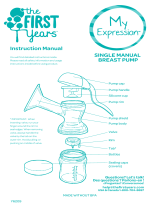
Questions? Visit www.medela.com or call us at 1-800-435-8316.
13
Caution
Too Small
Nipple
Areola
Correct Fit
Nipple
Areola
Too Large
Nipple
Areola
2.2 Correctly fi tting breast shields
1. Medela’s PersonalFit sizing
Pumping should not hurt. For maximum comfort and pumping effi ciency, Medela
offers fi ve breast shield sizes.
Visit MedelaBreastshields.com to view the full guide to help you determine your
optimal size based on your nipple diameter.
2. Test your breast shield size
1. Start with the 24 mm that came with your pump, or the size determined by
measuring.
2. Center nipple and gently hold breast shield against your breast.
3. Adjust for Maximum Comfort Vacuum
™
, to achieve optimum suction level.
4. Refer to images while pumping in expression.
3. Should you try a new size?
• Does your nipple rub sides of tunnel, to the point of causing discomfort?
• Do you see excessive areola being pulled into tunnel?
• Do you see any redness?
• Is your nipple or areola turning white?
• Do you feel unexpressed milk after pumping?
If you answered “YES” to any of these questions, consider trying a new size by
following the measuring instructions above.
If you are still unsure if you selected the correct size, see a lactation consultant,
breastfeeding specialist, or visit MedelaBreastshields.com for assistance in choosing
the right size breast shield.
Visit MedelaBreastshields.com to view the full guide
to help you determine your
36
mm
27
mm
30
mm
24
mm
21
mm
• Nipple rubs along
side of tunnel
• Try a larger size
• Nipple is centered
and moves freely
• Nipple and excessive
areola are pulled into
the tunnel
• Try a smaller size
• While some discomfort may be felt when fi rst using a breast pump, using the breast pump should
not cause pain.
• If you are experiencing discomfort at the base of the nipple due to rubbing of your breast tissue with
the breast shield tunnel, use of a lubricant such as Tender Care
™
Lanolin may be benefi cial.
• For assistance with correct breast shield sizing and comfort please visit www.medelabreast shields.
com or see a lactation consultant / breastfeeding specialist.




















